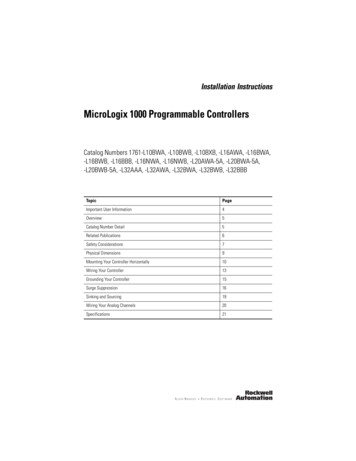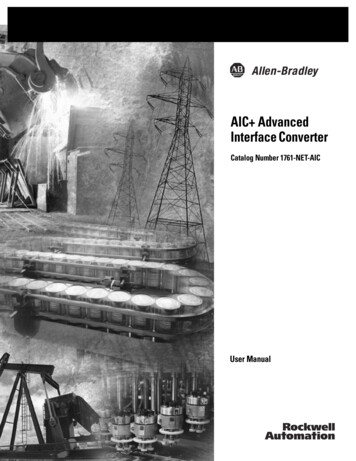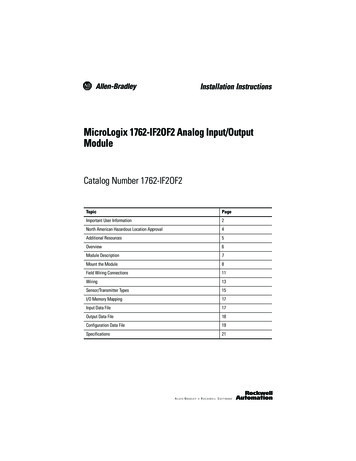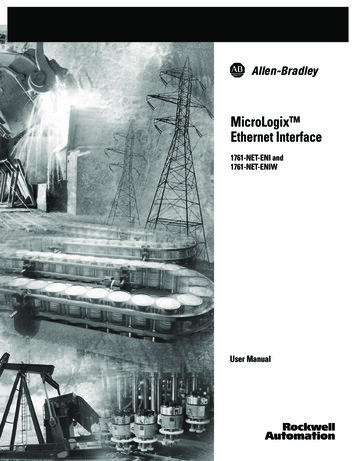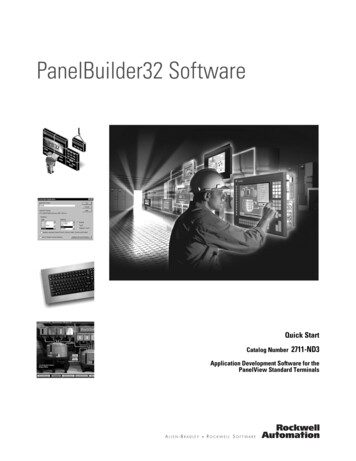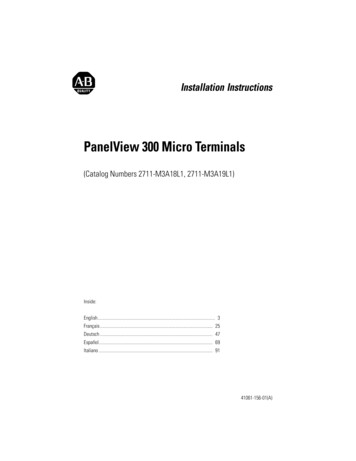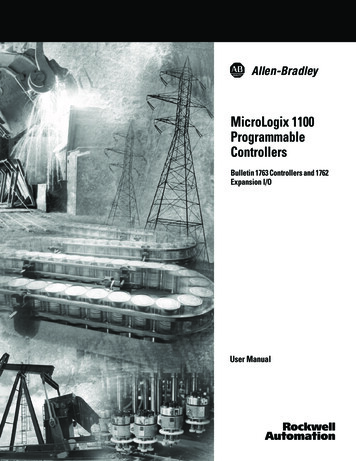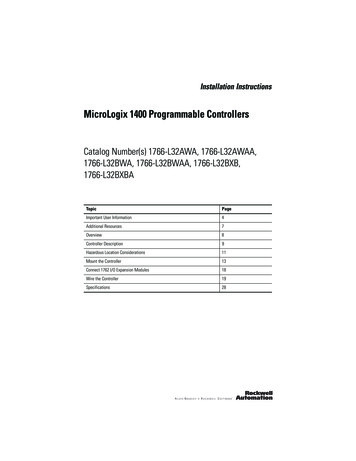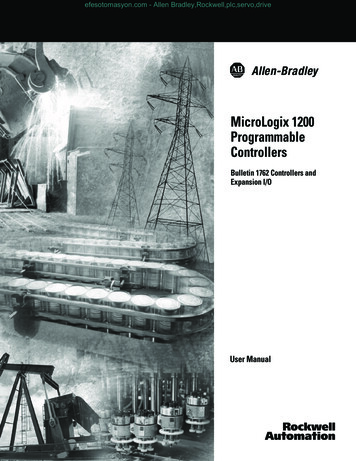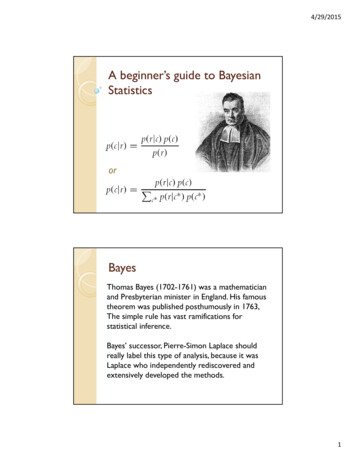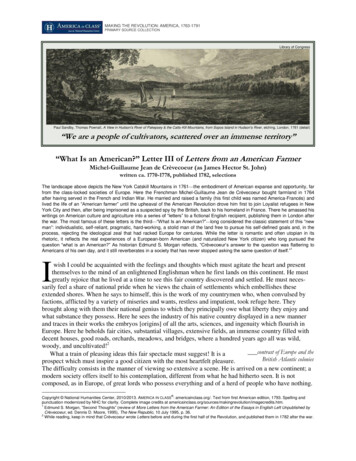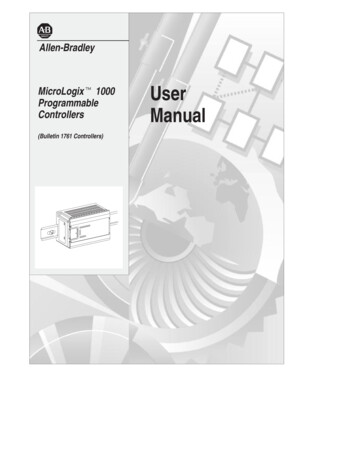
Transcription
Allen-BradleyMicroLogix 1000ProgrammableControllers(Bulletin 1761 Controllers)UserManual
Table of ContentsTable of ContentsPreface - - - - - - - - - - - - - - - - - - - - - - - - - - - - - - - - - - - - - - - - - - - - - - - P-1Who Should Use this Manual. . . . . . . . . . . . . . . . . . . . . . . . . . . . . . . . . P-1Purpose of this Manual . . . . . . . . . . . . . . . . . . . . . . . . . . . . . . . . . . . . . P-1Common Techniques Used in this Manual . . . . . . . . . . . . . . . . . . . . . . P-5Allen–Bradley Support . . . . . . . . . . . . . . . . . . . . . . . . . . . . . . . . . . . . . . P-5Hardware1Installing Your ControllerCompliance to European Union Directives . . . . . . . . . . . . . . . . . . . . . . 1-2Hardware Overview . . . . . . . . . . . . . . . . . . . . . . . . . . . . . . . . . . . . . . . . 1-2Master Control Relay . . . . . . . . . . . . . . . . . . . . . . . . . . . . . . . . . . . . . . . 1-4Using Surge Suppressors . . . . . . . . . . . . . . . . . . . . . . . . . . . . . . . . . . . 1-8Safety Considerations . . . . . . . . . . . . . . . . . . . . . . . . . . . . . . . . . . . . . 1-10Power Considerations . . . . . . . . . . . . . . . . . . . . . . . . . . . . . . . . . . . . . 1-12Preventing Excessive Heat . . . . . . . . . . . . . . . . . . . . . . . . . . . . . . . . . 1-13Controller Spacing . . . . . . . . . . . . . . . . . . . . . . . . . . . . . . . . . . . . . . . . 1-14Mounting the Controller . . . . . . . . . . . . . . . . . . . . . . . . . . . . . . . . . . . . 1-152Wiring Your ControllerGrounding Guidelines . . . . . . . . . . . . . . . . . . . . . . . . . . . . . . . . . . . . . . 2-2Sinking and Sourcing Circuits . . . . . . . . . . . . . . . . . . . . . . . . . . . . . . . . 2-3Wiring Recommendations . . . . . . . . . . . . . . . . . . . . . . . . . . . . . . . . . . . 2-4Wiring Diagrams, Discrete Input and Output Voltage Ranges . . . . . . . . 2-71761-L32AWA Wiring Diagram . . . . . . . . . . . . . . . . . . . . . . . . . . . . . . . 2-9Minimizing Electrical Noise on Analog Controllers. . . . . . . . . . . . . . . . 2-22Grounding Your Analog Cable . . . . . . . . . . . . . . . . . . . . . . . . . . . . . . . 2-22Wiring Your Analog Channels . . . . . . . . . . . . . . . . . . . . . . . . . . . . . . . 2-23Analog Voltage and Current Input and Output Ranges . . . . . . . . . . . . 2-24Wiring Your Controller for High-Speed Counter Applications . . . . . . . 2-253Connecting the SystemConnecting the DF1 Protocol . . . . . . . . . . . . . . . . . . . . . . . . . . . . . . . . . 3-2toc-i
MicroLogix 1000 Programmable Controllers User ManualConnecting to a DH–485 Network . . . . . . . . . . . . . . . . . . . . . . . . . . . . . 3-6Connecting the AIC . . . . . . . . . . . . . . . . . . . . . . . . . . . . . . . . . . . . . . 3-10Establishing Communication . . . . . . . . . . . . . . . . . . . . . . . . . . . . . . . . 3-19Programming4Programming OverviewPrinciples of Machine Control . . . . . . . . . . . . . . . . . . . . . . . . . . . . . . . . 4-2Understanding File Organization . . . . . . . . . . . . . . . . . . . . . . . . . . . . . . 4-4Understanding How Processor Files are Stored and Accessed . . . . . . 4-6Addressing Data Files . . . . . . . . . . . . . . . . . . . . . . . . . . . . . . . . . . . . . 4-10Applying Ladder Logics to Your Schematics . . . . . . . . . . . . . . . . . . . . 4-14Developing Your Logic Program - A Model . . . . . . . . . . . . . . . . . . . . . 4-155Using AnalogI/O Image . . . . . . . . . . . . . . . . . . . . . . . . . . . . . . . . . . . . . . . . . . . . . . . . 5-2I/O Configuration . . . . . . . . . . . . . . . . . . . . . . . . . . . . . . . . . . . . . . . . . . 5-3Input Filter and Update Times . . . . . . . . . . . . . . . . . . . . . . . . . . . . . . . . 5-3Converting Analog Data . . . . . . . . . . . . . . . . . . . . . . . . . . . . . . . . . . . . . 5-56Using Basic InstructionsAbout the Basic Instructions. . . . . . . . . . . . . . . . . . . . . . . . . . . . . . . . . . 6-2Bit Instructions Overview . . . . . . . . . . . . . . . . . . . . . . . . . . . . . . . . . . . . 6-3Examine if Closed (XIC) . . . . . . . . . . . . . . . . . . . . . . . . . . . . . . . . . . . . . 6-3Examine if Open (XIO) . . . . . . . . . . . . . . . . . . . . . . . . . . . . . . . . . . . . . . 6-4Output Energize (OTE) . . . . . . . . . . . . . . . . . . . . . . . . . . . . . . . . . . . . . 6-4Output Latch (OTL) and Output Unlatch (OTU) . . . . . . . . . . . . . . . . . . . 6-5One–Shot Rising (OSR). . . . . . . . . . . . . . . . . . . . . . . . . . . . . . . . . . . . . 6-6Timer Instructions Overview. . . . . . . . . . . . . . . . . . . . . . . . . . . . . . . . . . 6-7Timer On–Delay (TON) . . . . . . . . . . . . . . . . . . . . . . . . . . . . . . . . . . . . 6-10Timer Off–Delay (TOF) . . . . . . . . . . . . . . . . . . . . . . . . . . . . . . . . . . . . 6-11Retentive Timer (RTO) . . . . . . . . . . . . . . . . . . . . . . . . . . . . . . . . . . . . . 6-13Counter Instructions Overview . . . . . . . . . . . . . . . . . . . . . . . . . . . . . . . 6-15Count Up (CTU) . . . . . . . . . . . . . . . . . . . . . . . . . . . . . . . . . . . . . . . . . . 6-17Count Down (CTD). . . . . . . . . . . . . . . . . . . . . . . . . . . . . . . . . . . . . . . . 6-18Reset (RES) . . . . . . . . . . . . . . . . . . . . . . . . . . . . . . . . . . . . . . . . . . . . . 6-20toc--ii
Table of ContentsBasic Instructions in the Paper Drilling Machine Application Example 6-217Using Comparison InstructionsAbout the Comparison Instructions . . . . . . . . . . . . . . . . . . . . . . . . . . . . 7-2Comparison Instructions Overview . . . . . . . . . . . . . . . . . . . . . . . . . . . . 7-2Equal (EQU). . . . . . . . . . . . . . . . . . . . . . . . . . . . . . . . . . . . . . . . . . . . . . 7-3Not Equal (NEQ) . . . . . . . . . . . . . . . . . . . . . . . . . . . . . . . . . . . . . . . . . . 7-3Less Than (LES) . . . . . . . . . . . . . . . . . . . . . . . . . . . . . . . . . . . . . . . . . . 7-3Less Than or Equal (LEQ) . . . . . . . . . . . . . . . . . . . . . . . . . . . . . . . . . . . 7-4Greater Than (GRT). . . . . . . . . . . . . . . . . . . . . . . . . . . . . . . . . . . . . . . . 7-4Greater Than or Equal (GEQ) . . . . . . . . . . . . . . . . . . . . . . . . . . . . . . . . 7-4Masked Comparison for Equal (MEQ) . . . . . . . . . . . . . . . . . . . . . . . . . . 7-5Limit Test (LIM) . . . . . . . . . . . . . . . . . . . . . . . . . . . . . . . . . . . . . . . . . . . 7-6Comparison Instructions in the Paper Drilling Machine Application Example7-88Using Math InstructionsAbout the Math Instructions . . . . . . . . . . . . . . . . . . . . . . . . . . . . . . . . . . 8-2Math Instructions Overview . . . . . . . . . . . . . . . . . . . . . . . . . . . . . . . . . . 8-2Add (ADD) . . . . . . . . . . . . . . . . . . . . . . . . . . . . . . . . . . . . . . . . . . . . . . . 8-4Subtract (SUB) . . . . . . . . . . . . . . . . . . . . . . . . . . . . . . . . . . . . . . . . . . . . 8-532–Bit Addition and Subtraction. . . . . . . . . . . . . . . . . . . . . . . . . . . . . . . 8-6Multiply (MUL) . . . . . . . . . . . . . . . . . . . . . . . . . . . . . . . . . . . . . . . . . . . . 8-8Divide (DIV) . . . . . . . . . . . . . . . . . . . . . . . . . . . . . . . . . . . . . . . . . . . . . . 8-9Double Divide (DDV) . . . . . . . . . . . . . . . . . . . . . . . . . . . . . . . . . . . . . . 8-10Clear (CLR) . . . . . . . . . . . . . . . . . . . . . . . . . . . . . . . . . . . . . . . . . . . . . 8-11Square Root (SQR) . . . . . . . . . . . . . . . . . . . . . . . . . . . . . . . . . . . . . . . 8-11Scale Data (SCL) . . . . . . . . . . . . . . . . . . . . . . . . . . . . . . . . . . . . . . . . . 8-12Math Instructions in the Paper Drilling Machine Application Example . 8-149Using Data Handling InstructionsAbout the Data Handling Instructions. . . . . . . . . . . . . . . . . . . . . . . . . . . 9-2Convert to BCD (TOD) . . . . . . . . . . . . . . . . . . . . . . . . . . . . . . . . . . . . . . 9-3Convert from BCD (FRD) . . . . . . . . . . . . . . . . . . . . . . . . . . . . . . . . . . . . 9-4Decode 4 to 1 of 16 (DCD). . . . . . . . . . . . . . . . . . . . . . . . . . . . . . . . . . . 9-8Encode 1 of 16 to 4 (ENC) . . . . . . . . . . . . . . . . . . . . . . . . . . . . . . . . . . . 9-9Copy File (COP) and Fill File (FLL) Instructions . . . . . . . . . . . . . . . . . 9-10Move and Logical Instructions Overview . . . . . . . . . . . . . . . . . . . . . . . 9-13toc-iii
MicroLogix 1000 Programmable Controllers User ManualMove (MOV). . . . . . . . . . . . . . . . . . . . . . . . . . . . . . . . . . . . . . . . . . . . . 9-15Masked Move (MVM) . . . . . . . . . . . . . . . . . . . . . . . . . . . . . . . . . . . . . . 9-16And (AND) . . . . . . . . . . . . . . . . . . . . . . . . . . . . . . . . . . . . . . . . . . . . . . 9-18Or (OR) . . . . . . . . . . . . . . . . . . . . . . . . . . . . . . . . . . . . . . . . . . . . . . . . 9-19Exclusive Or (XOR) . . . . . . . . . . . . . . . . . . . . . . . . . . . . . . . . . . . . . . . 9-20Not (NOT). . . . . . . . . . . . . . . . . . . . . . . . . . . . . . . . . . . . . . . . . . . . . . . 9-21Negate (NEG) . . . . . . . . . . . . . . . . . . . . . . . . . . . . . . . . . . . . . . . . . . . 9-22FIFO and LIFO Instructions Overview . . . . . . . . . . . . . . . . . . . . . . . . . 9-23FIFO Load (FFL) and FIFO Unload (FFU) . . . . . . . . . . . . . . . . . . . . . . 9-25LIFO Load (LFL) and LIFO Unload (LFU) . . . . . . . . . . . . . . . . . . . . . . 9-26Data Handling Instructions in the Paper Drilling Machine ApplicationExample . . . . . . . . . . . . . . . . . . . . . . . . . . . . . . . . . . . . . . . . . . . . . . . . 9-2810Using Program Flow Control InstructionsAbout the Program Flow Control Instructions . . . . . . . . . . . . . . . . . . . 10-2Jump (JMP) and Label (LBL) . . . . . . . . . . . . . . . . . . . . . . . . . . . . . . . . 10-2Jump to Subroutine (JSR), Subroutine (SBR), and Return (RET) . . . . 10-4Master Control Reset (MCR) . . . . . . . . . . . . . . . . . . . . . . . . . . . . . . . . 10-7Temporary End (TND) . . . . . . . . . . . . . . . . . . . . . . . . . . . . . . . . . . . . . 10-8Suspend (SUS) . . . . . . . . . . . . . . . . . . . . . . . . . . . . . . . . . . . . . . . . . . 10-8Immediate Input with Mask (IIM) . . . . . . . . . . . . . . . . . . . . . . . . . . . . . 10-9Immediate Output with Mask (IOM) . . . . . . . . . . . . . . . . . . . . . . . . . . . 10-9Program Flow Control Instructions in the Paper Drilling Machine ApplicationExample . . . . . . . . . . . . . . . . . . . . . . . . . . . . . . . . . . . . . . . . . . . . . . . 10-1011Using Application Specific InstructionsAbout the Application Specific Instructions . . . . . . . . . . . . . . . . . . . . . 11-2Bit Shift Instructions Overview . . . . . . . . . . . . . . . . . . . . . . . . . . . . . . . 11-3Bit Shift Left (BSL) . . . . . . . . . . . . . . . . . . . . . . . . . . . . . . . . . . . . . . . . 11-5Bit Shift Right (BSR). . . . . . . . . . . . . . . . . . . . . . . . . . . . . . . . . . . . . . . 11-6Sequencer Instructions Overview . . . . . . . . . . . . . . . . . . . . . . . . . . . . 11-7Sequencer Output (SQO) and Sequencer Compare (SQC) . . . . . . . . 11-7Sequencer Load (SQL) . . . . . . . . . . . . . . . . . . . . . . . . . . . . . . . . . . . 11-14Selectable Timed Interrupt (STI) Function Overview . . . . . . . . . . . . . 11-17Selectable Timed Disable (STD) and Enable (STE) . . . . . . . . . . . . . 11-20Selectable Timed Start (STS) . . . . . . . . . . . . . . . . . . . . . . . . . . . . . . 11-22Interrupt Subroutine (INT) . . . . . . . . . . . . . . . . . . . . . . . . . . . . . . . . . 11-22toc--iv
Table of ContentsApplication Specific Instructions in the Paper Drilling Machine ApplicationExample . . . . . . . . . . . . . . . . . . . . . . . . . . . . . . . . . . . . . . . . . . . . . . . 11-2312Using High–Speed Counter InstructionsAbout the High–Speed Counter Instructions . . . . . . . . . . . . . . . . . . . . 12-2High–Speed Counter Instructions Overview . . . . . . . . . . . . . . . . . . . . 12-2High–Speed Counter (HSC). . . . . . . . . . . . . . . . . . . . . . . . . . . . . . . . . 12-6High–Speed Counter Load (HSL) . . . . . . . . . . . . . . . . . . . . . . . . . . . 12-18High–Speed Counter Reset (RES) . . . . . . . . . . . . . . . . . . . . . . . . . . 12-21High–Speed Counter Reset Accumulator (RAC) . . . . . . . . . . . . . . . . 12-22High–Speed Counter Interrupt Enable (HSE) and Disable (HSD) . . . 12-23Update High–Speed Counter Image Accumulator (OTE) . . . . . . . . . 12-24What Happens to the HSC When Going to REM Run Mode . . . . . . . 12-25High-Speed Counter Instruction in the Paper Drilling Machine ApplicationExample . . . . . . . . . . . . . . . . . . . . . . . . . . . . . . . . . . . . . . . . . . . . . . . 12-2913Using the Message InstructionTypes of Communication . . . . . . . . . . . . . . . . . . . . . . . . . . . . . . . . . . . 13-2Message Instruction (MSG) . . . . . . . . . . . . . . . . . . . . . . . . . . . . . . . . . 13-3Timing Diagram for a Successful MSG Instruction . . . . . . . . . . . . . . . 13-8MSG Instruction Error Codes . . . . . . . . . . . . . . . . . . . . . . . . . . . . . . . 13-10Application Examples that Use the MSG Instruction . . . . . . . . . . . . . 13-13Troubleshooting14Troubleshooting Your SystemUnderstanding the Controller LED Status . . . . . . . . . . . . . . . . . . . . . . 14-2Controller Error Recovery Model . . . . . . . . . . . . . . . . . . . . . . . . . . . . . 14-5Identifying Controller Faults . . . . . . . . . . . . . . . . . . . . . . . . . . . . . . . . . 14-6Calling Allen-Bradley for Assistance . . . . . . . . . . . . . . . . . . . . . . . . . 14-11toc-v
MicroLogix 1000 Programmable Controllers User ManualReferenceAHardware ReferenceController Specifications . . . . . . . . . . . . . . . . . . . . . . . . . . . . . . . . . . . . A-2Controller Dimensions . . . . . . . . . . . . . . . . . . . . . . . . . . . . . . . . . . . . . A-11Replacement Parts. . . . . . . . . . . . . . . . . . . . . . . . . . . . . . . . . . . . . . . . A-12BProgramming ReferenceController Status File . . . . . . . . . . . . . . . . . . . . . . . . . . . . . . . . . . . . . . . B-1Instruction Execution Times and Memory Usage. . . . . . . . . . . . . . . . . B-25CValid Addressing Modes and File Types for Instruction ParametersAvailable File Types . . . . . . . . . . . . . . . . . . . . . . . . . . . . . . . . . . . . . . . .C-2Available Addressing Modes . . . . . . . . . . . . . . . . . . . . . . . . . . . . . . . . .C-2DUnderstanding the CommunicationProtocolsRS-232 Communication Interface . . . . . . . . . . . . . . . . . . . . . . . . . . . . .D-1DF1 Full-Duplex Protocol . . . . . . . . . . . . . . . . . . . . . . . . . . . . . . . . . . . .D-2DF1 Half-Duplex Slave Protocol . . . . . . . . . . . . . . . . . . . . . . . . . . . . . .D-5DH–485 Communication Protocol . . . . . . . . . . . . . . . . . . . . . . . . . . . .D-10EApplication Example ProgramsPaper Drilling Machine Application Example . . . . . . . . . . . . . . . . . . . . . E-2Time Driven Sequencer Application Example . . . . . . . . . . . . . . . . . . . E-17Event Driven Sequencer Application Example. . . . . . . . . . . . . . . . . . . E-19Bottle Line Example . . . . . . . . . . . . . . . . . . . . . . . . . . . . . . . . . . . . . . . E-21Pick and Place Machine Example . . . . . . . . . . . . . . . . . . . . . . . . . . . . E-24RPM Calculation Application Example . . . . . . . . . . . . . . . . . . . . . . . . . E-28On/Off Circuit Example . . . . . . . . . . . . . . . . . . . . . . . . . . . . . . . . . . . . E-34Spray Booth Application Example . . . . . . . . . . . . . . . . . . . . . . . . . . . . E-36Adjustable Timer Application Example. . . . . . . . . . . . . . . . . . . . . . . . . E-41FOptional Analog Input Software CalibrationCalibrating an Analog Input Channel . . . . . . . . . . . . . . . . . . . . . . . . . . . F-2Glossary - - - - - - - - - - - - - - - - - - - - - - - - - - - - - - - - - - - - - - - - - - - - - -G-1Index - - - - - - - - - - - - - - - - - - - - - - - - - - - - - - - - - - - - - - - - - - - - - - - - - H-1toc--vi
Summary of ChangesSummary of ChangesThe information below summarizes the changes to this manual since the last printingas Publication 1761–6.3 — July 1998.To help you find new information and updated information in this release of themanual, we have included change bars as shown to the right of this paragraph.New InformationThe table below lists sections that document new features and additional informationabout existing features, and shows where to find this new information.For This New InformationSeeUpdated explosion hazard informationpage 1-15Added 1761-CBL-AH02 and 1761-CBL-PH02to cable selectionpage 3-14Removed catalog 1761-NET-DNIChapter 3Updated relay life specificationspage A-6Added relay life chartpage A-6Updated InformationChanges from the previous release of this manual that require you to referenceinformation differently are as follows: The DeviceNet communications information has been updated; see chapter 3,Connecting the System. For updated information on automatic protocol switching, see chapter 3,Connecting the System. The MicroLogix 1000 programmable controllers’ VA ratings and power supplyinrush specifications have been updated; see appendix A, Hardware Reference.SOC-ix
MicroLogix 1000 Programmable Controllers User Manual SOC-xThe DF1 Full–Duplex and DH–485 configuration parameters have been updated;see appendix D, Understanding Communication Protocols.
PrefacePrefaceRead this preface to familiarize yourself with the rest of the manual. It providesinformation concerning: who should use this manual the purpose of this manual conventions used in this manual Allen–Bradley supportWho Should Use this ManualUse this manual if you are responsible for designing, installing, programming, ortroubleshooting control systems that use MicroLogix 1000 controllers.You should have a basic understanding of electrical circuitry and familiarity withrelay logic. If you do not, obtain the proper training before using this product.Purpose of this ManualThis manual is a reference guide for MicroLogix 1000 controllers. It describes theprocedures you use to install, wire, program, and troubleshoot your controller. Thismanual: explains how to install and wire your controllers gives you an overview of the MicroLogix 1000 controller system provides the MicroLogix 1000 controllers’ instruction set contains application examples to show the instruction set in useSee your programming software user manual for information on programming yourMicroLogix 1000 controller. For information on using the Hand-Held Programmerwith the MicroLogix 1000 controllers, see the MicroLogix 1000 with Hand-HeldProgrammer (HHP) User Manual, Publication 1761-6.2.P-1
MicroLogix 1000 Programmable Controllers User ManualContents of this sPrefaceDescribes the purpose, background, and scope of thismanual. Also specifies the audience for whom this manualis intended.1Installing YourControllerProvides controller installation procedures and systemsafety considerations.2Wiring Your ControllerProvides wiring guidelines and diagrams.3Connecting theSystemGives information on wiring your controller system for theDF1 protocol or DH–485 network.4ProgrammingOverviewProvides an overview of principles of machine control, asection on file organization and addressing, and a programdevelopment model.5Using AnalogProvides information on I/O image file format, I/Oconfiguration, input filter and update times, and conversionof analog data.6Using BasicInstructionsDescribes how to use ladder logic instructions for relayreplacement functions, counting, and timing.7Using ComparisonInstructionsDescribes how to use the instructions to compare values ofdata in your ladder logic program.8Using MathInstructionsDescribes how to use the ladder logic instructions thatperform basic math functions.9Using Data HandlingInstructionsDescribes how to perform data handling instructions,including move and logical instructions and FIFO and LIFOinstructions.10Using Program FlowControl InstructionsDescribes the ladder logic instructions that affect programflow and execution.11Using ApplicationSpecific InstructionsDescribes the bit shift, sequencer and STI relatedinstructions.12Using High-SpeedCounter InstructionsDescribes the four modes of the high-speed counter and itsrelated instructions.13Using the MessageInstructionProvides a general overview of the types of communication,and explains how to establish network communication usingthe message instruction.
ting YourSystemReferenceContentsExplains how to interpret and correct problems with yourMicroLogix 1000 controller system.Appendix A Hardware ReferenceProvides physical, electrical, environmental, and functionalspecifications.Appendix B ProgrammingReferenceExplains the system status file and provides instructionexecution times.Valid AddressingModes and File TypesAppendix C for InstructionParametersProvides a listing of the instructions along with theirparameters and valid file types.Understanding theAppendix D CommunicationProtocolsContains descriptions of the DF1 protocol and DH–485network.Appendix E Application ExampleProgramsProvides advanced application examples for the high–speedcounter, sequencer, bit shift, and message instructions.Analog InputAppendix F OptionalSoftware CalibrationExplains how to calibrate your controller using softwareoffsets.GlossaryContains definitions for terms and abbreviations that arespecific to this product.Related DocumentationThe following documents contain additional information concerning Allen–Bradleyproducts. To obtain a copy, contact your local Allen–Bradley office or distributor.ForRead this DocumentA procedural manual for technical personnel who use theMicroLogix 1000 with Hand–Allen–Bradley Hand–Held Programmer (HHP) to monitor andHeld Programmer (HHP) Userdevelop control logic programs for the MicroLogix 1000Manualcontroller.DocumentNumber1761-6.2P-3
MicroLogix 1000 Programmable Controllers User ManualForInformation on mounting and wiring the MicroLogix 1000 controllers, including a mounting template for easyinstallationRead this DocumentDocumentNumberMicroLogix 1000Programmable ControllersInstallation Instructions1761–5.1.2MicroLogix 1000 (Analog)Programmable ControllersInstallation Instructions1761–5.1.3The procedures necessary to install and connect the AIC and DNIAdvanced Interface Converter(AIC ) and DeviceNet Interface(DNI) Installation Instructions1761–5.11A description on how to install and connect an AIC . Thismanual also contains information on network wiring.Advanced Interface Converter(AIC ) User Manual1761–6.4Information on how to install, configure, and commission aDNIDeviceNet Interface User ManualIn–depth information on grounding and wiring Allen–Bradleyprogrammable controllersA description of important differences between solid–stateprogrammable controller products and hard–wiredelectromechanical devicesAn article on wire sizes and types for grounding electricalequipmentA complete listing of current documentation, includingordering instructions. Also indicates whether the documentsare available on CD–ROM or in multi–languages.A glossary of industrial automation terms and abbreviationsInformation on understanding and applying MicroLogix 1000 controllersP-4Allen–Bradley ProgrammableController Grounding and WiringGuidelinesApplication Considerations for Solid–State ControlsNational Electrical Code1761–6.51770–4.1SGI–1.1Published bythe NationalFire ProtectionAssociation ofBoston, MA.SD499Allen–Bradley Publication IndexAllen–Bradley Industrial AutomationGlossaryMicroMentorAG–7.11761–MMB
PrefaceCommon Techniques Used in this ManualThe following conventions are used throughout this manual: Bulleted lists such as this one provide information, not procedural steps. Numbered lists provide sequential steps or hierarchical information. Italic type is used for emphasis.Allen–Bradley SupportAllen–Bradley offers support services worldwide, with over 75 Sales/Support Offices,512 authorized Distributors and 260 authorized Systems Integrators locatedthroughout the United States alone, plus Allen–Bradley representatives in every majorcountry in the world.Local Product SupportContact your local Allen–Bradley representative for: sales and order support product technical training warranty support support service agreementsTechnical Product AssistanceIf you need to contact Allen–Bradley for technical assistance, please review theinformation in the Troubleshooting chapter first. Then call your local Allen–Bradleyrepresentative.P-5
MicroLogix 1000 Programmable Controllers User ManualYour Questions or Comments on this ManualIf you find a problem with this manual, or you have any suggestions for how thismanual could be made more useful to you, please contact us at the address below:Allen–Bradley Company, Inc.Control and Information GroupTechnical Communication, Dept. 602V, T122P.O. Box 2086Milwaukee, WI 53201–2086or visit our internet page at:http://www.ab.com/micrologixP-6
Installing Your ControllerInstalling Your ControllerHardware1This chapter shows you how to install your controller system. The only tools yourequire are a Flat head or Phillips head screwdriver and drill. Topics include: compliance to European Union Directives hardware overview master control relay surge suppressors safety considerations power considerations preventing excessive heat controller spacing mounting the controller1-1
MicroLogix 1000 Programmable Controllers User ManualCompliance to European Union DirectivesIf this product has the CE mark it is approved for installation within the EuropeanUnion and EEA regions. It has been designed and tested to meet the followingdirectives.EMC DirectiveThis product is tested to meet Council Directive 89/336/EEC ElectromagneticCompatibility (EMC) and the following standards, in whole or in part, documented ina technical construction file: EN 50081-2EMC – Generic Emission Standard, Part 2 – Industrial Environment EN 50082-2EMC – Generic Immunity Standard, Part 2 – Industrial EnvironmentThis product is intended for use in an industrial environment.Hardware OverviewThe MicroLogix 1000 programmable controller is a packaged controller containing apower supply, input circuits, output circuits, and a processor. The controller isavailable in 10 I/O, 16 I/O and 32 I/O configurations, as well as an analog versionwith 20 discrete I/O and 5 analog I/O.1-2
Installing Your ControllerThe catalog number for the controller is composed of the following:Bulletin NumberAnalog I/OBase UnitAnalog Circuits:Inputs 4Outputs 1Unit I/O Count: 20Input Signal:A 120V acB 24V dcHardware1761-L20AWA-5APower Supply:A 120/240V acB 24V dcOutput Type:W RelayB MOSFETA TriacThe hardware features of the controller ��➇➉Input terminalsdc output terminals (or not used)Mounting holeInput LEDsStatus LEDsRS-232 communication channelOutput LEDsPower supply line powerGround screwOutput terminals➈➉➂1-3
MicroLogix 1000 Programmable Controllers User ManualMaster Control RelayA hard-wired master control relay (MCR) provides a reliable means for emergencycontroller shutdown. Since the master control relay allows the placement of severalemergency-stop switches in different locations, its installation is important from asafety standpoint. Overtravel limit switches or mushroom head push buttons arewired in series so that when any of them opens, the master control relay isde-energized. This removes power to input and output device circuits. Refer to thefigure on page 1-6.!ATTENTION: Never alter these circuits to defeat their function, since seriousinjury and/or machine damage could result.Note:If you are using an external dc output power supply, interrupt the dcoutput side rather than the ac line side of the supply to avoid theadditional delay of power supply turn-off.The external ac line of the dc output power supply should be fused.Connect a set of master control relays in series with the dc powersupplying the input and output circuits.Place the main power disconnect switch where operators and maintenance personnelhave quick and easy access to it. If you mount a disconnect switch inside thecontroller enclosure, place the switch operating handle on the outside of theenclosure, so that you can disconnect power without opening the enclosure.Whenever any of the emergency-stop switches are opened, power to input and outputdevices should be removed.When you use the master control relay to remove power from the external I/O circuits,power continues to be provided to the controller’s power supply so that diagnosticindicators on the processor can still be observed.1-4
The master control relay is not a substitute for a disconnect to the controller. It isintended for any situation where the operator must quickly de-energize I/O devicesonly. When inspecting or installing terminal connections, replacing output fuses, orworking on equipment within the enclosure, use the disconnect to shut off power tothe rest of the system.Note:Do not control the master control relay with the controller. Provide theoperator with the safety of a direct connection between an emergencystop switch and the master control relay.Using Emergency-Stop SwitchesWhen using emergency-stop switches, adhere to the following points: Do not program emergency-stop switches in the controller program. Anyemergency-stop switch should turn off all machine power by turning off themaster control relay. Observe all applicable local codes concerning the placement and labeling ofemergency-stop switches. Ins
See your programming software user manual for information on programming your MicroLogix 1000 controller. For inform ation on using the Hand-Held Programmer with the MicroLogix 10 00 controllers, see the MicroLogix 1000 with Hand-Held Programmer (HHP) User Manual, Publication 1761-6.2.
